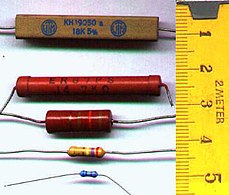Resistance measurement
Electrical resistance is a property of a specific conductive body. For the sake of simplicity, let us assume that such a body is equipped with two conductive terminals and that no electric current enters it anywhere else. There will be an electric current U between the terminals and electric current I will flow through the supply wire. The electrical resistance can be introduced, for example, using Ohm´s law (also in integral form) as a proportionality constant between the applied voltage U and the flowing current I:
The unit of electrical resistance is Ohm [Ω], multiplies of kΩ and MΩ are often used. The inverse of electrical resistance is called electrical conductivity G, its unit is Siemens [S].
Both electrical resistance and electrical conductivity are constants that characterize a specific body, in addition to the material, they are also influenced by its geometric configuration. Quantities are used to characterize a specific material:
- specific electrical resistance (conductivity) γ [S·m-1]
- specific electrical resistance (resistivity) ρ [Ω·m]
Measurement of electrical resistance[edit | edit source]
Ohm´s method[edit | edit source]
Electrical resistance is usually measured directly according to Ohm´s law (its so called integral form), that is, by allowing an electric current to flow though the body and measuring the voltage drop that occurs on the body. The resistance is then calculated according to the relationship:
We measure electric current with an ammeter and voltage with a voltmeter. Since it is usually necessary to measure voltage and current simultaneously, two arrangements are possible:
However, both arrangements are problematic in their own way. In the case of connection A, the voltmeter shows the actual voltage on the measured resistance, but the ammeter shows the sum of the currents passing through the measured resistance and the voltmeter. This arrangement is suitable where the current passing through the measured resistance is significantly higher than the current passing through the voltmeter, i.e. if the measured resistance will be relatively small. With the known resistance value of the voltmeter RV, a correction can be made and the unknown resistance can be calculated according to the relationship:
In connection B, the current flowing through the resistance is measured accurately, but the measured voltage drop is increased by the voltage drop on the ammeter. This arrangement will be suitable where the voltage drop on the measured resistance is significantly higher than the voltage drop on the ammeter, i.e. at relatively high values of the measured resistance. With a known value of the internal resistance of the ammeter, a correction can be made:
Substitution method[edit | edit source]
The substitution method of measuring electrical resistance is implemented by connecting an unknown resistance to a source of constant electrical voltage and measuring the flowing electrical current. After that, a calibrated variable resistor (usually a resistor decade) is connected and its value is experimentally set so that the same current flows though the circuit as when the unknown resistor was connected to the circuit. If the same current flows, the value on the resistance decade is equal to the unknown resistance. The unknown resistance is thus substituted by a known resistance as long as it is possible to select a resistance through which the same current flows.
Analogously, it is possible to perform measurements with a source of constant electric current. The only modification would be to measure voltage drops.
Other methods[edit | edit source]
In some cases, other methods are used to measure electrical resistance. This is mainly the comparative method and the bridge method.
Links[edit | edit source]
Related Articles[edit | edit source]
- Current measurement
- Voltage measurement
- Measurement of impedance
- Conductivity measurement of solutions
Source[edit | edit source]
- KUBATOVA, Senta. Biophoto [online]. [cit. 2011-01-31]. <https://uloz.to/!CM6zAi6z/biofot-doc>.
Literature[edit | edit source]
- HAASZ, Vladimír – SEDLÁČEK, Miloš. Elektrická měření: přístroje a metody. 1. edition. Prague : CTU Publishing House, 1998. 327 pp. ISBN 80-01-01717-6.
External links[edit | edit source]
- textbook Praktická elektronika on WikiBooks







